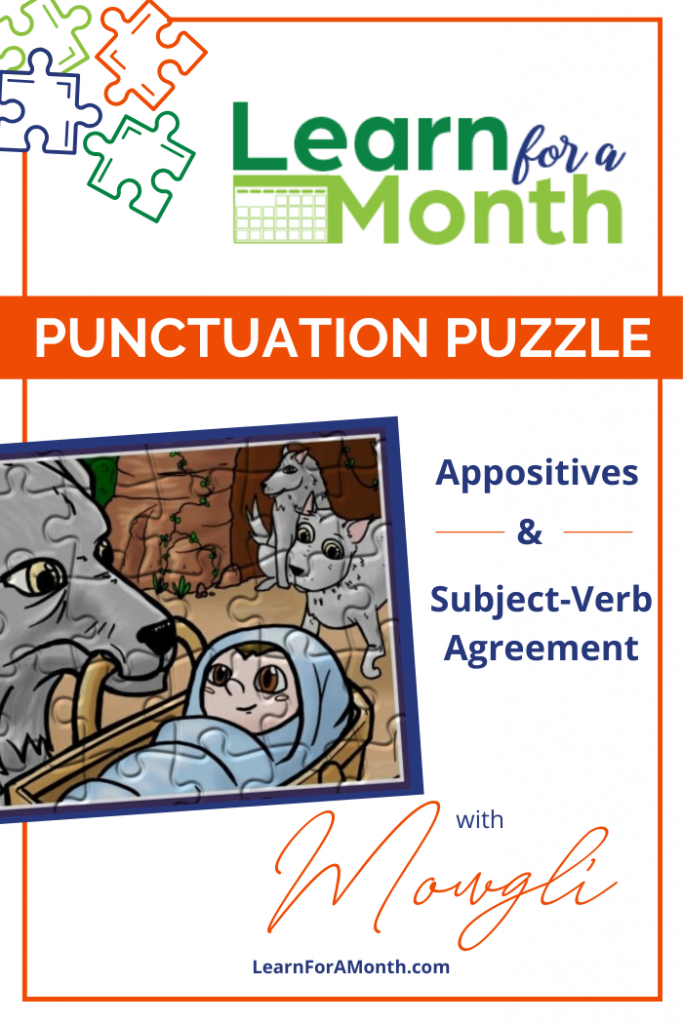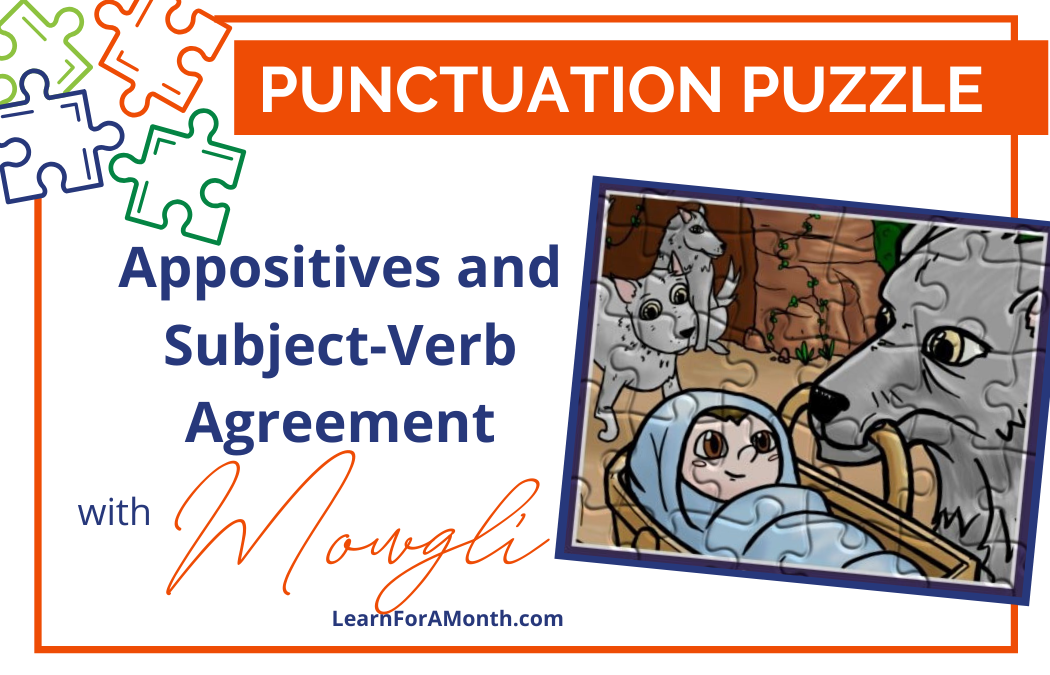By Zac Kieser and Donna Reish
My writing assistant, Zachary Kieser, and I are having so much fun coming up with these Punctuation Puzzles! They are interesting ways to brush up on grammar and usage skills that you might be rusty on—and great for junior high and high school students to do with you since the answers are explained thoroughly. Add this to your school day for more learning fun with your kids!
Today’s Punctuation Puzzle sentence comes from a student writing assignment found in one of our downloadable (also available in print) book, Write On, Mowgli—our Twice-Told Tale lesson!

Shere Khan the tiger, out of all the animals, were the first to speak.
The answer?
Shere Khan, the tiger, out of all the animals, was the first to speak.
Now let me explain the concepts behind that answer:
Appositives –
1. An appositive is a phrase that renames or restates the words before it.
a. In this case, what renames Shere Khan? The tiger.
b. You can easily identify an appositive by replacing the phrase the appositive is renaming with the appositive itself; if the sentence still makes sense, then you have an appositive:
Shere Khan, out of all the animals, was the first to speak.
The tiger, out of all the animals, was the first to speak.
c. Shere Khan can be replaced by the tiger and the sentence still makes sense.
d. However, let’s say we wrote, Shere Khan, surprisingly, out of all the animals, was the first to speak. What happens when we apply our test?
Shere Khan, out of all the animals, was the first to speak.
Surprisingly, out of all the animals, was the first to speak.
e. Replacing Shere Khan with surprisingly obviously does not make sense (unless his name is Surprisingly, which could be a character’s name, just not in this story!). Surprisingly could remain where it is, as an adverb, but it is not an appositive.
2. We have identified the tiger as an appositive.
a. We need to make it follow the two rules for an appositive:
~ It must immediately follow the words it restates AND
~ It must be set off, by commas, from the rest of the sentence
b. It already follows the first one, but we have to add the commas to make it follow the second rule.
c. This gives us a first sentence that reads, “Shere Khan, the tiger, out of all the animals, were the first to speak.”
However, something is still wrong in this sentence! That takes us to our next topic: Subject-Verb Agreement.
Subject-Verb Agreement –
1. We all recognize that the subject and verb must agree in a sentence. You wouldn’t say, “We IS going to the zoo today”; is is singular (i.e. “Jill is going to the zoo today.” One person is going to the zoo, so we use the singular verb form). Instead, you would write, “We ARE going to the zoo today.” Are is plural, and we refers to multiple people.
2. However, when we have a sentence like, “Shere Khan, the tiger, out of all the animals, was the first to speak”, things get tricky. The main reason for this is that the subject and verb are separated by two phrases. So how do we sort this out?
a. First, we have to realize that we want the verb to agree with SUBJECT, not the phrases. Therefore, let’s identify those phrases. The tiger and out of all the animals are the phrases (we already discussed the first and the second is a prepositional phrases).
b. Now that we’ve identified the phrases, we need to temporarily remove the phrases. Do the subject and the verb agree in this sentence?
“Shere Khan were the first to speak.”
They do not. Shere Khan is one animal, and were is plural (referring to multiple animals).
c. Let’s fix this. All we need to do is replace were with a singular form of be that makes sense. In this case, that would be was.
“Shere Khan was the first to speak.”
This gives us a singular subject—one tiger—with a singular verb was.
d. With the correct verb in place, we just put the phrases back into the sentence. That gives us our finished product:
“Shere Khan, the tiger, out of all the animals, was the first to speak.”
Aren’t Punctuation Puzzles fun?
Love and hope,
Donna (and Zac!)
P.S. What would you like to see a Punctuation Puzzle about? What are your troublesome usage areas? We can help you! 🙂
This Punctuation Puzzle was written by Zac Kieser and Donna Reish.

